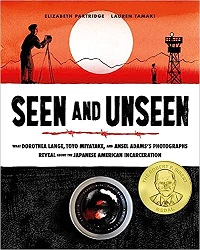
 Seen and Unseen
Seen and UnseenWhat Dorothea Lange, Toyo Miyatake, and Ansel Adams's Photographs Reveal About the Japanese American Incarceration
Chronicle Books, 2022. 124 pages.
Review written February 26, 2023, from a library book.
Starred Review
2023 Sibert Award Winner
Seen and Unseen won the Sibert Award for the best informational book for children published in 2022. The book tells the story of the imprisonment of Japanese Americans during World War II, especially looking at the testimony of three photographers.
Here's the beginning of Dorothea Lange's section:
In the San Francisco Bay area, Dorothea Lange was asked to photograph the roundup and forced relocation of all Japanese and Japanese Americans on the West Coast. Officials wanted documentary photos to show it was being carried out in a humane, orderly way.
Dorothea was horrified by the government's plan. The prisoners would be held without charges filed against them and without the right to a trial. That was illegal in the United States. But there was a war on, and Japanese Americans' rights were suspended.
Dorothea could have refused, but she ws eager to take the job. She wanted her photographs to show what the government was doing was unfair and undemocratic.
We see many of the pictures she took in the pages that follow, along with descriptions of what was going on. But most of the ones we see are labeled "Impounded" -- they were withheld from the public during the war, to try to hide the brutal conditions of the imprisonment of American citizens.
Meanwhile, photographer Toyo Miyatake was imprisoned in the camps. He smuggled in his camera lens and took photos, giving a starker and more realistic picture of life in the camp.
Later in the war, he was asked to open an official photography studio to document special events like weddings and funerals. But in a silly and humiliating bit of red tape, they wouldn't let him press the button on the camera and they hired a white American to do that.
The final photographer featured is Ansel Adams. He came in 1943, paid by the government, to support "loyal" Japanese Americans being resettled in other parts of America. They showed him happy faces -- not necessarily the true story.
This book as a whole shows how a terrible national tragedy was presented to the public in general at the time. The book is full of illustrations as well as photographs and vividly presents what happened.
I thought this page was particularly striking, with a picture of a father talking to a little boy:
"I don't know what's going to happen to your mother and me," future US Congressman Norman Mineta's Issei father told him and his four siblings. "But just remember: All of you are US citizens and this is your home. There is nothing anyone can do to take this away from you."
He was wrong.
